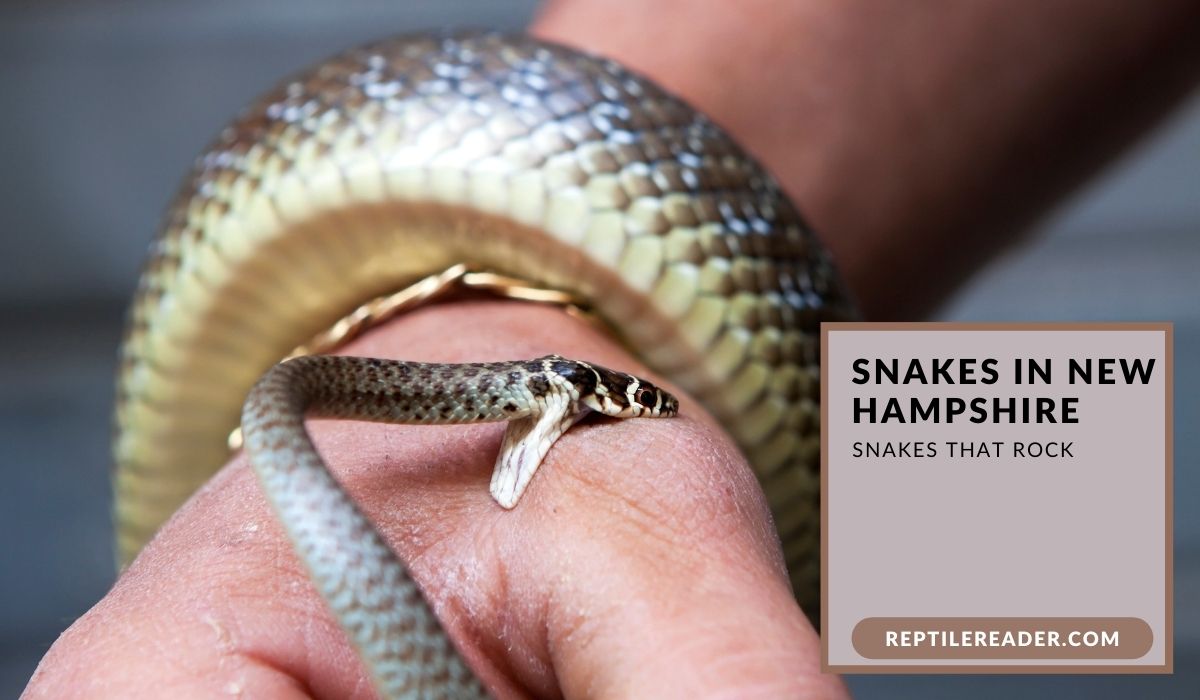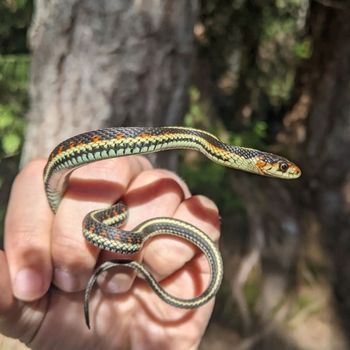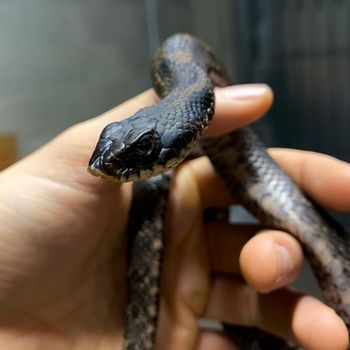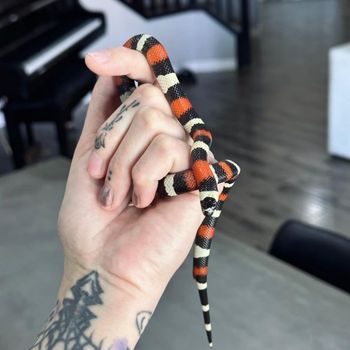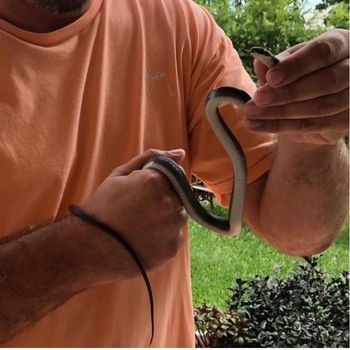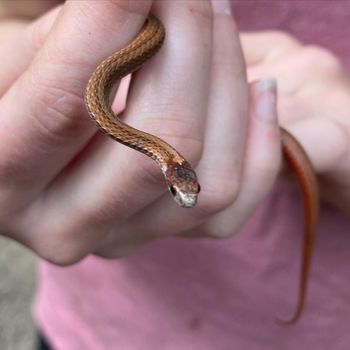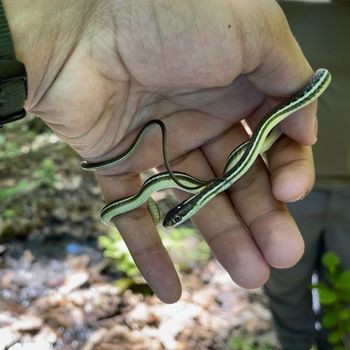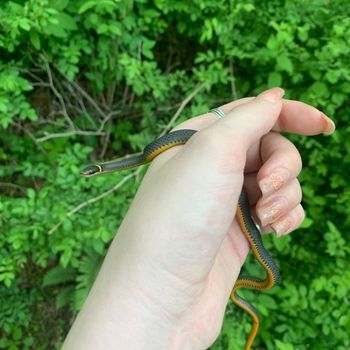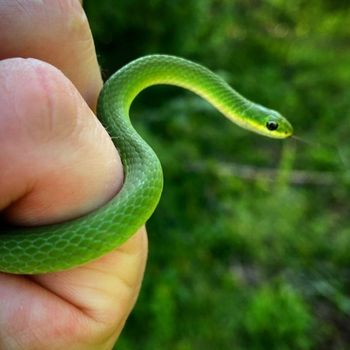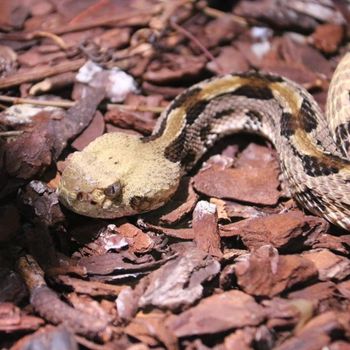Snakes in New Hampshire: Snakes That Rock
Ever been on a nature walk in New Hampshire and suddenly caught sight of a slithering reptile cross your path? Well, there’s no need to worry as New Hampshire just has 11 species of snakes!
Now, you must be curious about these fascinating creatures found right here in our lovely state. So, whether you’re an avid nature enthusiast or just looking to learn about your local wildlife, this article is perfect for you!
Join us as we explore the incredible world of these reptiles and get to know a little more about the 11 amazing species that call New Hampshire home.
| # | Name | Details | Image |
| 1 | Common Garter Snake (Thamnophis sirtalis) |
| 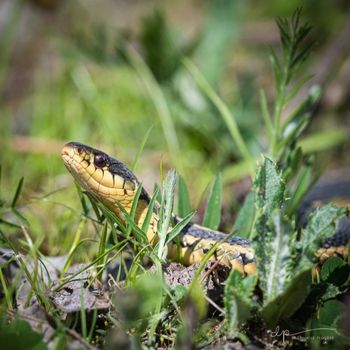 |
| 2 | Dekay’s Brownsnake (Storeria dekayi) |
| 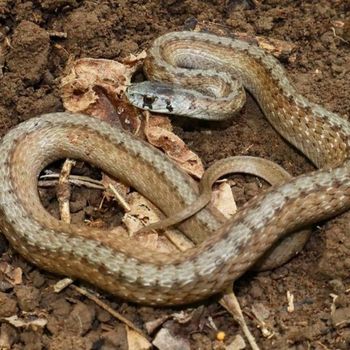 |
| 3 | Eastern Hog-nosed Snake (Heterodon platirhinos) |
| 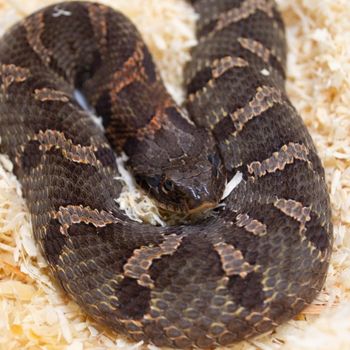 |
| 4 | Milksnake (Lampropeltis triangulum) |
| 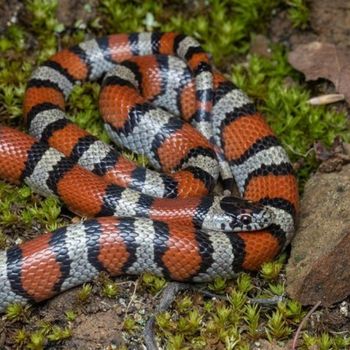 |
| 5 | North American Racer (Coluber constrictor) |
| 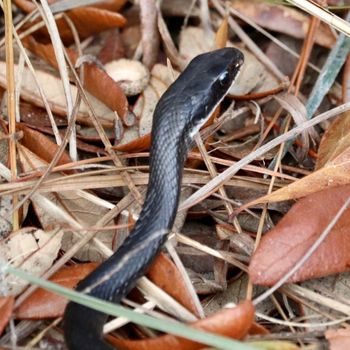 |
| 6 | Northern Water Snake (Nerodia sipedon) |
|  |
| 7 | Red-Bellied Snake (Storeria occipitomaculata) |
|  |
| 8 | Ribbon Snake (Thamnophis sauritus) |
| 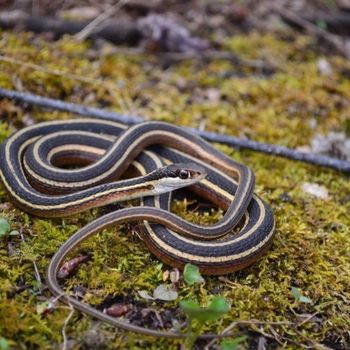 |
| 9 | Ringneck Snake (Diadophis punctatus) |
|  |
| 10 | Smooth Green Snake (Opheodrys vernalis) |
| 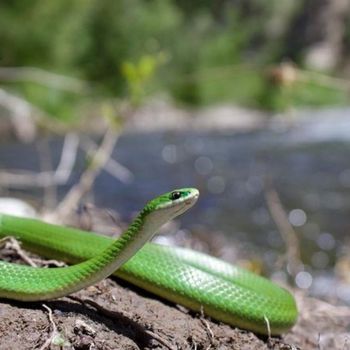 |
| 11 | Timber Rattlesnake (Crotalus horridus) |
|  |
11 Snakes You Can Find in New Hampshire
In the state of New Hampshire, a fascinating array of serpents can be found slithering through its diverse landscapes. From venomous to harmless, each species has its unique story to tell. Below, we’ll explore the wonders of these often misunderstood creatures of New Hampshire, from their natural habitats and behaviors to the challenges they face in our changing world.
1. Common Garter Snake
- Scientific Name: Thamnophis sirtalis
- Common Name: Common garter snake
- Size: Up to 3-4 feet (0.9-1.2 meters)
- Natural Habitat: Wet and moist habitats, including marshes, fields, and forests
- Color: Green or brown with three yellow stripes
- Habitat: Wet and moist habitats, including marshes, fields, and forests
- Maximum Size: Up to 3-4 feet (0.9-1.2 meters)
- Diet: Frogs, fish, earthworms, and small mammals
- Reproduction: Gives birth to live young, 10-40 per litter
- Venom: Mildly venomous, harmless to humans
- Conservation: Least concern
The Common Garter Snake (Thamnophis sirtalis) is a 3-4 feet (0.9-1.2 meters) non-aggressive and mildly venomous reptile with a green or brown body and three yellow stripes. Inhabiting wet and moist habitats like marshes, fields, and forests of New Hampshire, these diurnal snakes hibernate during winter to escape the cold. Their diet consists of frogs, fish, earthworms, and small mammals. Uniquely, these snakes birth live young, producing 10-40 per litter. Although venomous, they pose no threat to humans and are currently listed as a species of least concern for conservation.
2. Dekay’s Brownsnake
- Scientific Name: Storeria dekayi
- Common Name: Dekay’s brown snake
- Size: 9-15 inches (23-38 cm)
- Natural Habitat: Forests, grasslands, wetlands, and urban areas
- Color: Brown or gray with dark spots
- Habitat: Forests, grasslands, wetlands, and urban areas
- Maximum Size: 9-15 inches (23-38 cm)
- Diet: Earthworms, slugs, and other soft-bodied invertebrates
- Reproduction: Give birth to live young (ovoviviparous), 3-40 offspring
- Venom: Non-venomous
- Conservation: Least concern
Storeria dekayi, commonly known as Dekay’s Brown Snake, is a small, non-venomous reptile, measuring 9-15 inches (23-38 cm) in length. Its brown or gray body features dark spots, and it inhabits forests, grasslands, wetlands, and urban areas. Exhibiting terrestrial, nocturnal, and secretive behavior, its diet consists primarily of earthworms, slugs, and other soft-bodied invertebrates. A fascinating ovoviviparous species, Dekayís Brown Snake gives birth to live young, bearing 3-40 offspring. Its current conservation status is classified as least concern.
3. Eastern Hog-nosed Snake
- Scientific Name: Heterodon platirhinos
- Common Name: Eastern hog-nosed snake
- Size: 20-33 inches (51-84 cm)
- Natural Habitat: Woodlands, grasslands, and sandy areas
- Color: Highly variable, typically brown or gray with dark blotches
- Habitat: Woodlands, grasslands, and sandy areas
- Maximum Size: 20-33 inches (51-84 cm)
- Diet: Mostly toads, but also other amphibians and small mammals
- Reproduction: Lay eggs, 4-60 per clutch
- Venom: Mild venom, harmless to humans
- Conservation: Least concern
The Eastern Hog-nosed Snake (Heterodon platirhinos) is a moderately-sized serpent, reaching lengths of 20-33 inches (51-84 cm). Its coloration is highly variable, typically exhibiting brown or gray hues with dark blotches. Inhabiting woodlands, grasslands, and sandy areas, this diurnal snake is known for playing dead when threatened. Its diet mainly consists of toads, along with other amphibians and small mammals. It reproduces by laying 4-60 eggs per clutch, has mild venom harmless to humans, and is classified as of “Least Concern” in conservation efforts.
4. Milksnake
- Scientific Name: Lampropeltis triangulum
- Common Name: Milksnake
- Size: 20 to 60 inches (50 to 150 cm)
- Natural Habitat: Various habitats, including forests, grasslands, and rocky hillsides
- Color: Red or orange with black and white bands
- Habitat: Various habitats, including forests, grasslands, and rocky hillsides
- Maximum Size: 20 to 60 inches (50 to 150 cm)
- Diet: Rodents, birds, eggs, and other reptiles
- Reproduction: Lay eggs in clutches of 2-17
- Venom: Non-venomous
- Conservation: Least concern
The Milksnake (Lampropeltis triangulum) is a non-venomous and nocturnal reptile, ranging in size from 20 to 60 inches (50 to 150 cm) in length. It exhibits vibrant colors like red or orange, with black and white bands. Milksnakes inhabit various environments, such as forests, grasslands, and rocky hillsides. Their secretive nature makes them difficult to spot. The species primarily feeds on rodents, birds, eggs, and other reptiles. Reproduction involves laying egg clutches of 2-17. Currently, their conservation status is of least concern.
5. North American Racer
- Scientific Name: Coluber constrictor
- Common Name: North american racer
- Size: Up to 6 feet (1.8 meters)
- Natural Habitat: Grasslands, meadows, forests, and farmlands
- Color: Blue, gray, or greenish with a white or yellow underside
- Habitat: Grasslands, meadows, forests, and farmlands
- Maximum Size: Up to 6 feet (1.8 meters)
- Diet: Small mammals, birds, frogs, and insects
- Reproduction: Lay eggs in clutches of 4-30
- Venom: Non-venomous
- Conservation: Least concern
The North American Racer (Coluber constrictor) is a non-venomous snake species that can reach up to 6 feet (1.8 meters) in length. Characterized by blue, gray, or greenish scales and a white or yellow underside, these diurnal and terrestrial creatures inhabit grasslands, meadows, forests, and farmlands. Known for their fast-moving behavior, they primarily feed on small mammals, birds, frogs, and insects. North American Racers reproduce by laying eggs in clutches of 4-30, and their conservation status is listed as least concern.
6. Northern Water Snake
- Scientific Name: Nerodia sipedon
- Common Name: Northern water snake
- Size: Up to 4.5 feet (1.4 meters)
- Natural Habitat: Aquatic habitats, such as rivers, lakes, ponds, and marshes
- Color: Brown or gray with dark bands or blotches
- Habitat: Aquatic habitats, such as rivers, lakes, ponds, and marshes
- Maximum Size: Up to 4.5 feet (1.4 meters)
- Diet: Fish, amphibians, and invertebrates
- Reproduction: Lay eggs in clutches of 10-30
- Venom: Non-venomous
- Conservation: Least concern
The Northern Water Snake (Nerodia sipedon) is a non-venomous reptile that can grow up to 4.5 feet (1.4 meters) in length. It is characterized by its brown or gray color with dark bands or blotches. This nocturnal and semi-aquatic species can be found in a variety of aquatic habitats, including rivers, lakes, ponds, and marshes. Its diet consists of fish, amphibians, and invertebrates. Northern Water Snakes reproduce by laying eggs in clutches of 10-30, and currently have a conservation status of least concern.
7. Red-Bellied Snake
- Scientific Name: Storeria occipitomaculata
- Common Name: Red-bellied snake
- Size: 8-16 inches (20-41 cm)
- Natural Habitat: Forests, woodlands, and wetlands
- Color: Gray or brown with a red or orange belly
- Habitat: Forests, woodlands, and wetlands
- Maximum Size: 8-16 inches (20-41 cm)
- Diet: Slugs, snails, and earthworms
- Reproduction: Live-bearing; 4-21 offspring per litter
- Venom: Non-venomous
- Conservation: Least concern
The Red-Bellied Snake (Storeria occipitomaculata) is a small, non-venomous snake measuring 8-16 inches (20-41 cm) in length. They are gray or brown with a distinctive red or orange belly. Mostly found in forests, woodlands, and wetlands of New Hampshire, these nocturnal and secretive creatures primarily feed on slugs, snails, and earthworms. As live-bearing reptiles, they produce 4-21 offspring in each litter. With a conservation status of “Least Concern,” this terrestrial snake presents no significant threat to humans.
8. Ribbon Snake
- Scientific Name: Thamnophis sauritus
- Common Name: Eastern ribbon snake
- Size: 18-36 inches (45-91 centimeters)
- Natural Habitat: Wetland habitats such as marshes, swamps, and streams
- Color: Black or dark brown with thin, yellow or white stripes
- Habitat: Wetland habitats such as marshes, swamps, and streams
- Maximum Size: 18-36 inches (45-91 centimeters)
- Diet: Amphibians, small fish, and invertebrates
- Reproduction: Lay eggs in clutches of 3-26
- Venom: Non-venomous
- Conservation: Least concern
The Eastern Ribbon Snake (Thamnophis sauritus) is a non-venomous species of slender, fast-moving reptile measuring 18-36 inches (45-91 centimeters) in length. Its coloration includes black or dark brown tones with thin, yellow or white stripes. This snake thrives in wetland habitats such as marshes, swamps, and streams. Active during the day, it is a strong swimmer that feeds primarily on amphibians, small fish, and invertebrates. Reproducing through egg-laying, it is currently classified as a species of least concern conservation-wise.
9. Ringneck Snake
- Scientific Name: Diadophis punctatus
- Common Name: Ringneck snake
- Size: 12-15 inches (30-38 centimeters)
- Natural Habitat: Forests, grasslands, and urban areas
- Color: Gray or dark brown with yellow or orange ring around the neck
- Habitat: Forests, grasslands, and urban areas
- Maximum Size: 12-15 inches (30-38 centimeters)
- Diet: Small invertebrates such as insects, worms, and slugs
- Reproduction: Lay eggs in clutches of 3-10
- Venom: Mildly venomous, but not harmful to humans
- Conservation: Least concern
The Ringneck Snake (Diadophis punctatus) is a small, mildly venomous serpent, measuring 12-15 inches (30-38 centimeters) in length. Exhibiting a gray or dark brown coloration with a distinct yellow or orange ring around its neck, this species prefers habitats including forests, grasslands, and urban areas. As nocturnal, secretive creatures, Ringneck Snakes are found hiding under rocks or logs, feeding on small invertebrates such as insects, worms, and slugs. Reproducing by laying 3-10 eggs per clutch, this snake is presently classified as least concern in terms of conservation status.
10. Smooth Green Snake
- Scientific Name: Opheodrys vernalis
- Common Name: Smooth green snake
- Size: 14-20 inches (36-51 cm)
- Natural Habitat: Grasslands, meadows, and open woodlands
- Color: Bright green with a lighter belly
- Habitat: Grasslands, meadows, and open woodlands
- Maximum Size: 14-20 inches (36-51 cm)
- Diet: Insects and spiders
- Reproduction: Lay eggs in clutches of 3-12
- Venom: Non-venomous
- Conservation: Least concern
The Smooth Green Snake (Opheodrys vernalis) measures 14-20 inches (36-51 cm) and is characterized by its vibrant green color and lighter belly. Commonly found in grasslands, meadows, and open woodlands, this diurnal and terrestrial reptile is an adept climber. Its diet mainly consists of insects and spiders. In terms of reproduction, they lay eggs in clutches of 3-12. Though non-venomous, these snakes should be admired from afar. Fortunately, their conservation status is currently listed as ‘Least Concern.’
11. Timber Rattlesnake
- Scientific Name: Crotalus horridus
- Common Name: Timber rattlesnake
- Size: Up to 6 feet (1.8 meters)
- Natural Habitat: Forests, mixed woodlands, and rocky hillsides
- Color: Yellow, brown, gray, or black with dark bands
- Habitat: Forests, mixed woodlands, and rocky hillsides
- Maximum Size: Up to 6 feet (1.8 meters)
- Diet: Rodents, birds, and small mammals
- Reproduction: Viviparous, giving birth to 4-14 live young
- Venom: Hemotoxic venom
- Conservation: Least concern
The Timber Rattlesnake, scientifically known as Crotalus horridus, is a solitary, ambush predator that can grow up to 6 feet (1.8 meters) in length. It comes in various colors, including yellow, brown, gray, or black with dark bands, and inhabits forests, mixed woodlands, and rocky hillsides. Its diet consists of rodents, birds, and small mammals. Unlike most snakes, the Timber Rattlesnake is viviparous, giving birth to 4-14 live young. It possesses hemotoxic venom, and its conservation status is currently listed as least concern.
Nearby States:
Final Words
All the 11 snakes have truly opened our eyes to the fascinating world of snakes found in New Hampshire. Who knew there were so many different types of these slithering reptiles, each with their own unique characteristics and habitats?
Not only did we get a chance to learn about some of the more common and well-known species, but we also delved into the lesser-known and often misunderstood ones.
So, the next time you’re out and about in New Hampshire, keep an eye out for these incredible creatures, and let’s continue to appreciate and protect the diverse wildlife that makes our world so interesting!
What Types of Snakes Can be Found in New Hampshire?
New Hampshire is home to several species of cool snakes in maine, including the common garter snake, northern water snake, and milk snake. These snakes can be found in a variety of habitats, from forests and fields to marshes and wetlands. While some people may fear snakes, these creatures play important roles in the ecosystem.

